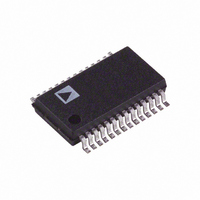AD1871YRS Analog Devices Inc, AD1871YRS Datasheet - Page 19

AD1871YRS
Manufacturer Part Number
AD1871YRS
Description
IC ADC STEREO AUDIO 24BIT 28SSOP
Manufacturer
Analog Devices Inc
Datasheet
1.AD1871YRSZ.pdf
(28 pages)
Specifications of AD1871YRS
Rohs Status
RoHS non-compliant
Number Of Bits
24
Sampling Rate (per Second)
96k
Data Interface
Serial, SPI™
Number Of Converters
2
Voltage Supply Source
Analog and Digital
Operating Temperature
-40°C ~ 105°C
Mounting Type
Surface Mount
Package / Case
28-SSOP (0.200", 5.30mm Width)
Available stocks
Company
Part Number
Manufacturer
Quantity
Price
Company:
Part Number:
AD1871YRS
Manufacturer:
AD
Quantity:
5 510
Company:
Part Number:
AD1871YRS
Manufacturer:
PHILIPS
Quantity:
5 510
Company:
Part Number:
AD1871YRSZ
Manufacturer:
AD
Quantity:
114
Part Number:
AD1871YRSZ
Manufacturer:
ADI/亚德诺
Quantity:
20 000
Cascade Mode
The AD1871 supports cascading of up to four devices in a
daisy-chain configuration to the serial port of a DSP. In Cascade
Mode, each device loads an internal 64-Bit Shift Register with
the results of the left and right channel conversions. The 64-
Bit Register is split into two subframes of 32 bits each; the first
for left channel data and the second for right channel data.
The results are left-justified, MSB first within the subframes,
and the word-width setting in Control Register II applies.
Remaining bits within the subframe, beyond the conversion
word-width, are set to zero. Please refer to Figure 16.
Up to four devices can be connected in a daisy chain as shown
in Figure 17. All devices must be set in Cascade Mode by tying
the CASC pin of each device to a logic high. The first device in
the chain (Device 4) has its DIN pin tied to logic low. Its
DOUT pin is connected to the DIN pin of Device 3 whose
DOUT is in turn connected to the DIN pin of Device 2. This
daisy chaining is continued until the DOUT of Device 1 is
connected to the DSP’s serial port RX data line (DR0). The
DSP’s RX serial clock (RXCLK0) is connected to the BCLK
pin of all AD1871 devices and the DSP’s RX frame sync (RFS0)
is connected to the LRCLK pin of all AD1871 devices.
REV. 0
16-BIT RESULT
24-BIT RESULT
20-BIT RESULT
32-BIT LEFT SUBFRAME
TXCLK1/RXCLK1
Figure 16. DSP Mode
ADSP-21xxx
SHARC DSP
TFS1/RFS1
RXCLK0
64-BIT FRAME
RFS0
DR1
DR0
DT1
16-BIT RESULT
20-BIT RESULT
24-BIT RESULT
32-BIT RIGHT SUBFRAME
AD1871 No.1
Figure 17. DSP Mode
AD1871 No.2
–19–
The DSP can be the master and supply the frame sync and
serial clock to the AD1871s, or one of the AD1871s can be
set as the master with the DSP and all other AD1871s set to
slave. Each sampling period begins with a frame sync being gener-
ated either by the DSP or one of the AD1871s, depending on
the Master/Slave selection. The frame-sync pulse causes each
device to load the 64-Bit Data I/O Register with the left and
right ADC results. These results are then clocked toward the
DSP where they are received in the following order: Device 1,
Left; Device 1, Right; Device 2, Left; Device 2, Right; Device 3,
Left; Device 3, Right; Device 4, Left; and Device 4, Right.
The DSP’s serial port must be programmed to accept 32-bit
word lengths regardless of the AD1871 word length. The number
of sample words to be accepted per sample interval will be
determined by the number of AD1871 devices in cascade, up
to a maximum of eight words corresponding with the maximum
number of four devices.
Figure 17 also shows the connection of a separate DSP serial port
interface to the control port (SPI) interface of the cascaded
AD1871s. Again this cascade is implemented as a daisy chain,
where the control words for the four devices are output in
sequence (depending on the hookup – 1, 2, 3, and 4 in the
example) to be latched simultaneously at each device by the
common CLATCH. In this mode, it is necessary to send a
control word for each device (16 bits
from the SPI port of the control host. The CLATCH signal can
be controlled from a separate programmable output line. It is
also possible to have individual read/write of the AD1871s
using separate CLATCH controls for each device.
When using Cascade Mode, the data interface defaults to left-
justified, MSB first data, regardless of the state of the Interface
Mode selection (by SPI or external control).
The timing relationships of the Cascade Mode are shown in
Figure 18.
AD1871 No.3
AD1871 No.4
the number of devices)
AD1871













